Viltrox is a Shenzhen based company in the People’s Republic of China. They have produced lenses since 2019. The company was founded back in 2009 and also does many other photography related products like adapters, lights and monitors.
Despite its young age in the lens line of business, Viltrox produces APS-C lenses for both Sony, Canon and Fujifilm. The lens in review here is the Viltrox 33 mm 1.4 prime for the Nikon Z mount. The Z mount is used by Nikon in their mirrorless series of camera bodies (say Z50 or Z6ii), and hence this lens cannot be used with Nikon DSLRs that use the older F-mount.
Introduction to this lens
You can get a 23mm and a 56mm lens for the Z-mount as well, but I chose to take a closer look at the 33 mm. You can read more about the alternatives here.
Viltrox kindly sent me a copy for review.

You probably already know that due to the crop factor, a 33mm APS-C lens is a 33×1.5=49.4 mm full frame equivalent. In other words, it is a nifty fifty 50mm, one of the most versatile general purpose focal lengths. Primes are more simple constructions than zooms, and hence often both cheaper, lighter and sharper than zooms, but I will stay clear of the pros and cons of primes vs zooms in this review and just assume that you are in the market for a 50 mm FF equivalent APS-C prime lens for the Nikon Z-mount.
You can use this lens on a full frame body like the Nikon Z6, but as it is intended for APS-C, you will either only use a fraction of the sensor of the FF camera (DX crop) or you will experience heavy vignetting where the corners are very dark. So in this review I have only tested the Viltrox lens on my Nikon Z50 – a little APS-C camera that I use a lot.
First look
The first thing I noticed was the weight of the package with the lens – around 300 grams! That may not sound like much, but relative to other APS-C lenses it is quite some! I like heavy lenses as it signals lots of glass and metal, and this lens is exactly like that – all metal and glass; even the lens hood is made of metal – no plastic here! Wonderful!
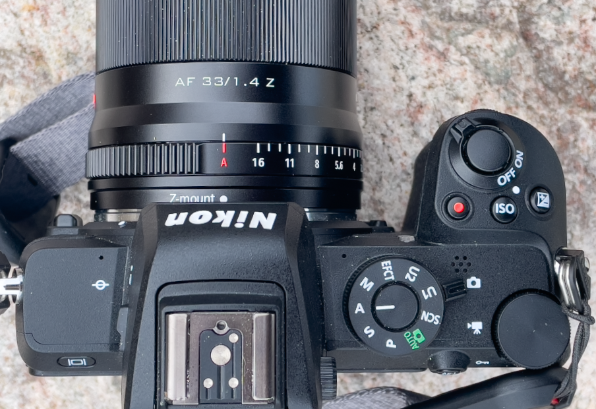
The solid build quality continues with the manual focus ring which is wide and easy to grip, and dampened just enough to give a bit of resistance without making the ring difficult to turn.
You can select the aperture on the lens by turning a click less ring close to the camera. If you turn it all the way to the right, so the mark is aligned with the red A, the lens allows you to select the aperture on the front command dial as you are used to, but as soon as you start turning the ring, the lens takes over control. I find that this works really well, and many Fuji shooters will love this feature. It will take me some time to get used to the lack of clicks on the ring.
The lens has a 52mm filter thread and there are no external parts that move due to the Internal focusing mechanism, making the use of filters easy. For the price point around 280 USD I did not expect to find autofocus (AF), but my expectations were surpassed, and the AF is both fast and silent.
Demanding videographers with microphones close to the camera may pick up a bit of noise from the motor, but the rest of us will be very happy with both the speed and the silence of the AF system in this lens. Perhaps needless to say, the lens comes with no stabilization – not that I would find it necessary in a lens this fast.

On the rear of the lens I found no rubber gaskets to give weather sealing and instead I found a little USB-C connector for future software updates. It is of course super useful when Viltrox is to push out new versions of the lens software either as improvements or to keep up with whatever changes Nikon may do. But it does certainly not give the impression of a lens that will withstand heavy rain or the elements on a stormy day at the beach. So I will not grab this lens for heavy weather conditions, unless wrapped in a plastic bag or similar to give protection from the elements. In all fairness, the Nikon Z50 is not weather sealed either, but I just think it would have been nice if Viltrox had gone to some length to protect the interface between the lens and camera from dust and moisture.
Use
The lens clicks onto the Nikon Z50 body like any other Nikon Z-mount lens. And from there on it just works. The AF is fast and silent and works in tandem with the Nikon camera body and I cannot tell the difference between a Nikon lens and a Viltrox lens in this regard.
The manual focus ring is big and wide and easy to use – I like the way it is dampened a bit but not too much and the focus peaking highlights makes manual override a pleasure. The only thing to get used to is the lack of clicks on the aperture ring, but I simply put the lens in mode “A” and control the aperture from the camera body.
This is a lens you will get used to in a matter of minutes.
Sharpness
Without bothering you with the more technical testing presented in a MTF chart, I can reveal that the sharpness of this lens is quite impressive, especially center sharpness. As with any lens that opens up as wide as f/1.4, you would expect some softness wide open and the lens to get sharper when stopping down.
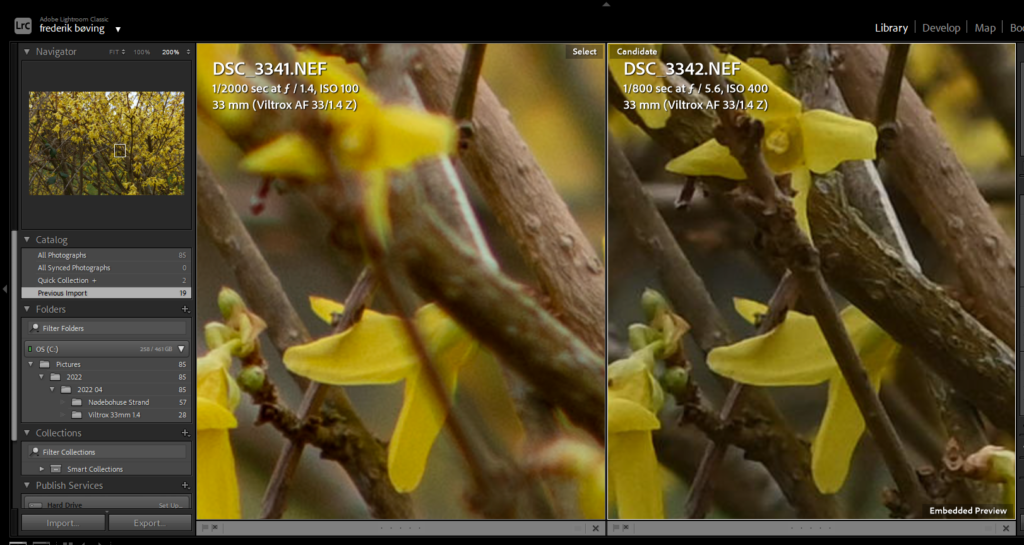
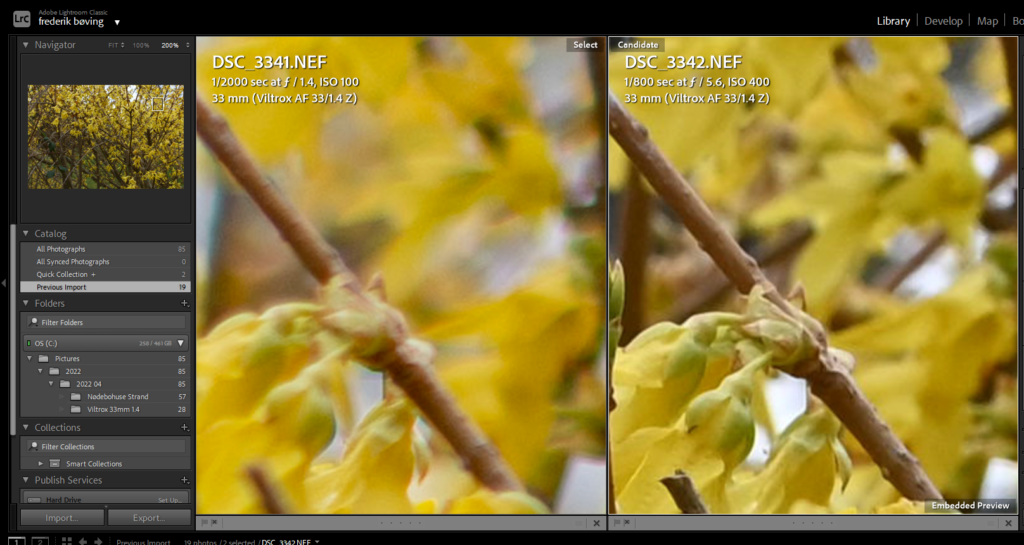
But this lens has impressive center sharpness also when fully open, whereas the corner sharpness leaves something to be desired. As soon as you stop down, then also the corners become very sharp.
Bokeh
There are 9 slightly rounded aperture blades. I prefer straight blades as I like sunstars when shooting stopped down into the sun, but on the other hand the rounded blades help produce rounded bokeh, so I guess you can’t have both. Aperture ranges from super fast f/1.4 down to f/16.
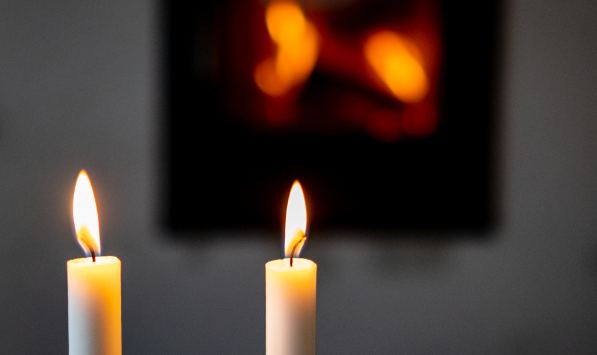
With a lens this fast, I guess that many want to use it for rendering beautiful blurred backgrounds. I find the bokeh absolutely beautiful and the 9 rounded blades certainly deliver according to my expectation. I know that bokeh experts will look for both cat’s eyes and onion rings, but I am not that advanced or demanding, and I simply find that the bokeh this lens produces when wide open is all I need.
Chromatic aberration
We all have different preferences and different things that are important to us. And when it comes to CA, I am one of the more demanding photographers. The reason being that I often shoot into the sun or in high contrast situations, and fixing CA in post processing is simply a nuisance. And on top of that, LR often does not remove the CA and I have to use an eyedropper tool and manual setting to get an acceptable result.
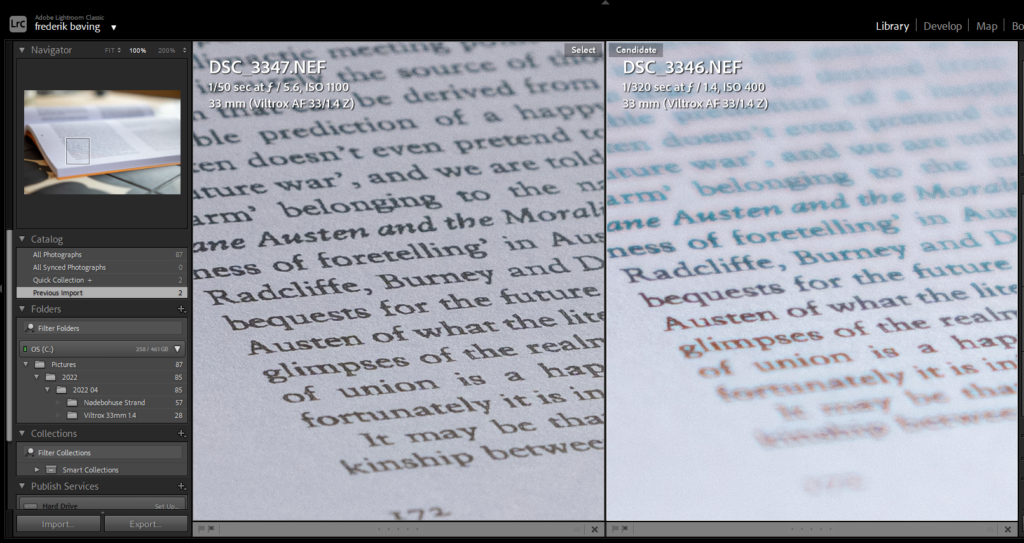
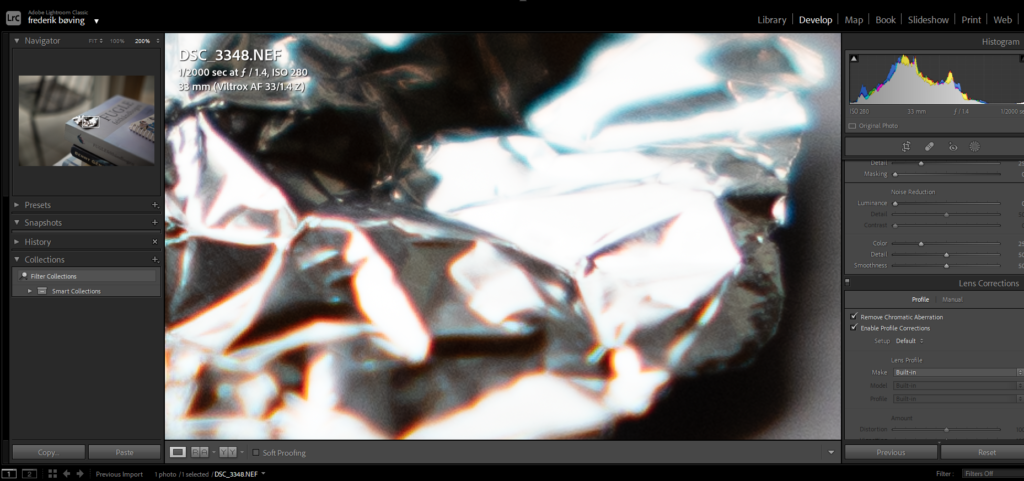
Unfortunately this lens suffers from CA and it is quite significant. The CA shows both as coloring of the letters when doing the classic “book” shot and also as clear lines of coloring when I do my party trick number one: shooting curly tinfoil in stark light. I know it is a brutal test, but my use of lenses when it comes to contrast is also brutal.
Minimum focus distance
The minimum focus distance for this lens is around 40cm according to the spec sheet, although I managed to get down to around 38cm in my own testing, measuring from the position of the sensor to the subject matter.

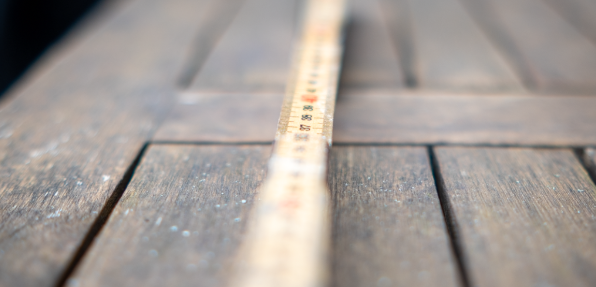
If you, like me, like to fill the frame with your subject, then a minimum focus distance of 38-40 cm is a lot, and you will find it annoying that you cannot get closer to the subject. In the picture with the little shell on the big black stone, you can see an example where it would have been nice to move closer to the subject. I had hoped for more, but if you shoot landscapes or portraits entirely, then the minimum focus distance may not be important to you at all.
Color rendition
I am very cautious when it comes to an assessment of color rendition, simply because it is super subjective and subject very much to personal preference and what color cast you are used to. If you have ever tried working with post processing of an image where you e.g. change the color temperature a lot, then take a 10 minute break and go for a cup of coffee and then come back to study your own work, only to find that the color rendition has been tweaked so badly that you immediately think “why did I not see this – it looks horrible?”. But the answer is that you slowly got used to it as you worked with the picture.
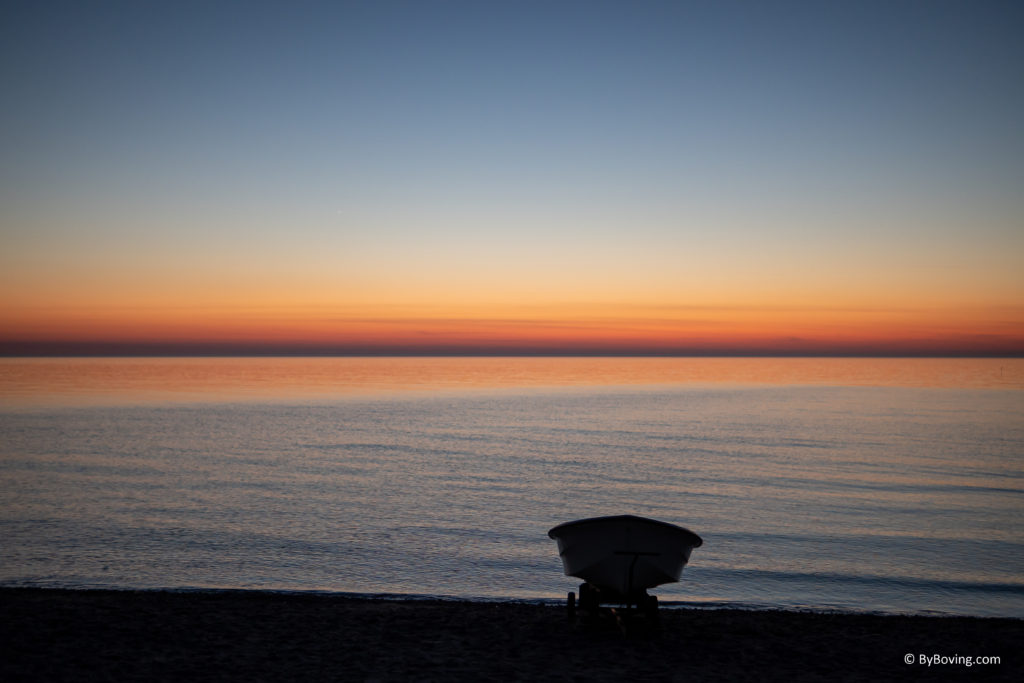
Long story short, then I think you will like the color rendition of this lens. I will give you some links to Flick towards the end of the review, so you can see some landscape images. The good image quality of Flickr can hopefully help you assess what you think of the color rendition.
Distortion
Back in the day when there was film in the camera, distortion was a big thing to avoid, as it would sit on your film after the shot was taken and there was very little you could do about it. With a digital image, lens profiles and smart post processing software, the removal of distortion is but a click away. And that is why I think that lens producers in their work to design the best lenses, simply let go of the ambition to contain or diminish distortion – there are other design criteria to give priority.
In that vein, I have not tested the lens for distortion. And even if I could not remove the problem with a few clicks in LR, I think that you will find that distortion – irrespective of barrel or pincushion – seldom is visible, unless you are a demanding architecture or real estate photographer that needs a straight line to be straight.
Focus breathing
Testing for focus breathing is really easy: Grab the manual focus ring and turn it back and forth and check in the viewfinder if the field of view changes, i.e. if it looks like the lens zooms in and out while you change focus point. If your lens has focus breathing, then you will see the field of view changing – your lens is “breathing” as it focuses near and far.
For videographers the absence of focus breathing is vital, as they often change focus in a scene where they need to shift focus from one actor to another. And exactly in those situations you don’t want the field of view to change. You want it to be rock steady.
I am happy to say that this lens has NO focus breathing, or at least so little that I cannot spot it. In combination with the fast and silent AF, the lack of focus breathing checks an important requirement for videographers.
Conclusion
I like a lens that delivers great value for money, and this lens checks that box in full. The Viltrox 33mm f/1.4 is a breath of fresh air to the Nikon Z-mount cameras, as you now can get a fast lens with great AF for a price well below the Nikon alternatives. And Viltrox did not spend all their focus on the inside of the lens – the build quality of the lens is great and the manual focus ring is a pleasure to use.
At this price point I did not expect to find AF, but it is there and works well, and further at this price point the expectation to find VR would be a bit unreasonable if you ask me – so I have put lack of VR as a point not assessed. I think at this price point it would be unfair to bring it up as a con.
Nobody’s perfect, and this lens has some weak points. One is corner sharpness that is less of an issue for me (and should be if you want to use this lens for say street photography or portraiture). Another is the strong CA in high contrast situations and the minimum focus distance that makes it hard to fill the frame with your subject. These are clear limitations for me that will influence what I will use this lens for.
So can I recommend this lens? Yes, if minimum focus distance and corner sharpness wide open is less of a concern for you, then this is a fast and well built value for money AF lens that can take up the 50mm FF equivalent spot in your APS-C prime lens collection for your Nikon Z-mount.
Pro
- Price / value for money
- Build quality
- AF speed and silence
- Maximum aperture at f/1.4
- Bokeh
- Centre sharpness
- No focus breathing
Cons
- Corner sharpness wide open
- Chromatic aberrations
- Minimum focus distance
- No weather sealing
Not assessed
- Color rendition
- Distortion
- Lack of VR
Video link
Sample images
Related reading
3 lenses for your Nikon APS-C Z-mount camera
What is a prime lens? And why use it?
